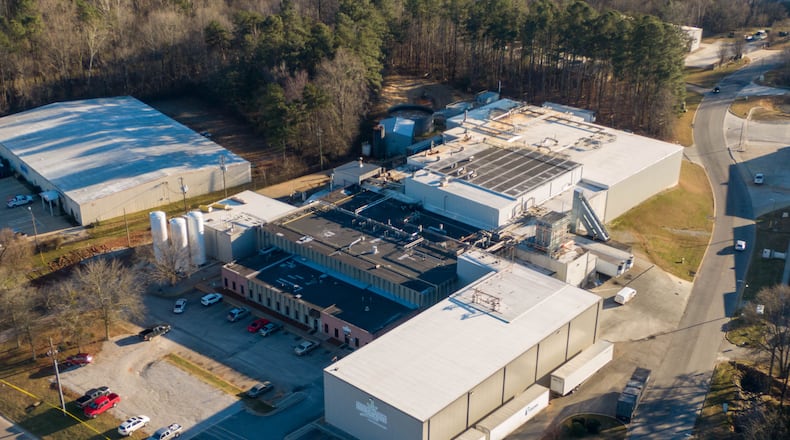On March 11, a Friday, the staff of an immigrant and workers’ rights non-profit based in Atlanta received a flurry of texts from workers at a Gainesville poultry plant. A pungent odor had filled the air, workers reported. There had been a chemical leak. Employees were being evacuated outdoors.
According to Shelly Anand, executive director of the Sur Legal Collaborative, the gist of many of the messages was: “It’s happened again.”
By the end of the day, emergency management authorities in Hall County confirmed there had been a bleach spill at the Gold Creek Foods chicken processing factory located on Memorial Park Drive. Four people were evaluated on the scene for minor injuries.
The bleach spill is the third chemical spill at the plant in 14 months. The two previous leaks in 2021 happened when the plant was under different ownership.
In January 2021, six workers died when a line carrying nitrogen was ruptured, releasing a frigid, odorless cloud. Less than two months later complaints of an ammonia leak emerged.
Labor advocates say the recurrence of chemical leaks at the poultry plant is indicative of workers’ lax safety rights in the meatpacking industry. For employees who have seen their colleagues die on the job, a situation like the March 11 bleach spill can be “retraumatizing,” according to Anand.
“When the ammonia leak was happening a year ago, we were getting really urgent phone calls in tears, people crying in bathrooms saying, ‘”Are we going to die too?’”
“They don’t feel safe,” added Stephanie Lopez-Burgos, legal assistant at Sur Legal. She is Gainesville-based and in frequent contact with workers. “Every time they go to work, they don’t know if they’re going to come back home.”
In response to an AJC inquiry, Gold Creek Foods shared a statement noting that the four employees who underwent medical evaluations on site following the bleach spill “were released and resumed duty that day … Gold Creek has followed up with these employees since the incident and no further problems or complaints have been reported.”
In an email, the Occupational Safety and Health Administration (OSHA) confirmed it has opened an investigation into the March 11 incident.
Reliance on chemicals
The headlines that the poultry plant has generated since 2021 have underscored mass-scale meat production’s reliance on chemical products. Inside processing plants, chemicals such as liquid nitrogen and ammonia are used to instantly freeze meat and keep ambient temperatures low, respectively.
Before being packaged for distribution, carcasses are treated with chlorine to help manage pathogens like salmonella and protect consumers from foodborne illness.
The role of chlorine and other antimicrobial rinses became more important as plants’ output rose, according to Debbie Berkowitz, a former chief of staff at OSHA and a current fellow at Georgetown University’s Kalmanovitz Initiative for Labor and the Working Poor.
“The industry over the last 40 years has really prioritized production… But the problem with prioritizing production and speed and having workers work harder and faster to get chickens to consumers is that it increases the likelihood of contamination.” The chemicals that the meat is imbibed in “supposedly dissipate” before they reach the consumer, Berkowitz explained, but still pose a threat to workers.
She added: “When people think of meat or poultry slaughter or processing, they never think, ‘Oh, these workers are also exposed to chemical hazards.’ But actually, the risk of illness and even death from chemicals used in the industry is almost equally as high as the risk of death and injury from the knives and the scissors and the wet floors and just the harsh physical conditions of the plants.”
The Sur Legal staff says workers themselves often lack a comprehensive understanding of the number and nature of chemicals in their vicinity, blaming insufficient training from their employers.
Regulators seem to share that view.
Last July, when OSHA concluded its investigation into the nitrogen leak — and imposed nearly $600,000 in penalties on the Foundation Food Group, the plant’s owner at the time — it noted that “employee training did not include the physical and health hazards of the chemicals in the work area.”
Failure to provide adequate training came up again in OSHA’s review of the ammonia leak.
Although the plant was sold to its current owner last fall, Sur Legal staff say they are worried the change in ownership didn’t meaningfully improve working conditions.
In its statement shared with the AJC, Gold Creek Foods noted that approximately 100 gallons of sodium hydrochlorite, a liquid bleach solution at a concentration of “just 12 percent” had leaked. For reference, the most common concentration of regular household bleach ranges between 5% and 9%, according to the Centers for Disease Control and Prevention.
The bleach solutions are less toxic than chlorine, which is a gas at room temperature.
Worker safety
According to the Gainesville-based Georgia Poultry Federation, Georgia is the nation’s leading poultry state, producing more than 31 million pounds of chicken every day.
According to a 2019 report from Human Rights Watch, workers at meat and poultry processing plants suffer some of the highest rates of occupational injury and illness in the U.S. To make matters worse, official data on workplace injuries is likely an undercount, report authors note, because it relies on workers reporting incidents to OSHA.
Concerns over immigration status or fear of retaliation can keep workers from engaging with authorities, advocates say.
According to Lopez-Burgos, many of the workers at the Memorial Park Drive plant are single mothers, with most hailing from Mexico or Central America, where they fled violence, abuse and poverty.
“They’re just trying to make it. They go to work even though they are in fear because they have no choice,” she said. “If they had a better option, they wouldn’t be there.”
Hispanic labor’s role helping power the poultry industry was on display in the death toll of last year’s nitrogen leak. Five of the six victims were Latino.
Across Gainesville, the self-proclaimed “Poultry Capital of the World,” 37% of the city’s population is Hispanic, per data from the 2020 U.S. Census. And according to estimates from the Pew Research Center, unauthorized immigrants in 2016 made up over 11.5% of Gainesville’s total population, virtually the largest proportion out of all U.S. metro areas.
Lopez-Burgos said when labor advocates tried to initiate conversations around employee rights in the immediate aftermath of the nitrogen leak, they were met with a cautious silence.
“These workers wouldn’t say even one word to us. They were there, they were listening, but they were not speaking. That’s how much fear there was. It took a long time for us to gain their trust.”
A sign of that earned trust is the speed with which workers reached out to Sur Legal on the day of the bleach spill earlier this month.
“I think every time it’s an act of bravery when they decide to talk to OSHA or even just calling us,” Anand said. “But I think in this facility in particular, bearing witness to six workers dying pushed a lot of these workers to say, ‘Enough.’”
Lautaro Grinspan is a Report for America corps member covering metro Atlanta’s immigrant communities.
About the Author
Keep Reading
The Latest
Featured



